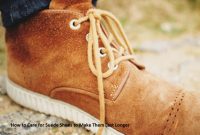For runners, sport shoes are not just footwear. But a valuable investment that supports performance and prevents injury. However, another important aspect is often forgotten, namely how to tie shoes. How could it not be, shoe lacing patterns for running have significant differences. Especially in comfort, safety, and even efficiency of movement when running. Let’s review in more detail.
Various Shoe Lacing Patterns for Running and Their Functions
Before discussing the various lacing techniques, it is important to understand the basic components of shoelaces and how they work. Shoelaces are usually made of strong but flexible materials. With hard ends to make it easier to insert them into the holes.
The main function of shoelaces is to tighten the shoes evenly across the entire foot. So that it can provide the support the user needs and prevent unwanted shifting when moving.
The tightness of the shoelaces affects how the feet feel in the shoes. Proper adjustment can reduce pressure at certain points, accommodate the shape of the foot and help overcome specific problems. Such as heels that are often lifted or pressure on the top of the foot.
Shoelaces that are too tight can cause irritation and excessive pressure. While loose laces are at risk of coming loose and disrupting concentration. Even often cause stumbling. Let’s explore the various lacing patterns for running shoes to provide maximum comfort and ensure that your shoes stay laced tightly as you conquer every kilometer.
1. Standard Criss-Cross
This is the most common lacing technique and is the basis for many other variations. The method is simple: insert the laces into the bottom hole from the outside in. Then cross both ends of the laces and insert them into the next hole from the inside out.
Repeat the process until you reach the top hole. This technique provides a fairly even adjustment across the entire foot. Make sure the laces are not too tight or too loose at each level.
2. Parallel Lacing
According to the Running With Dusty YouTube channel, this technique is ideal for runners who feel excessive pressure on the top of their feet. The method is to insert one end of the lace straight up through the inside of the hole.
Then cross it over the hole on the opposite side at the same level. The other end of the lace also goes straight up and is crossed. This pattern creates a parallel lacing path across the top of the shoe. This can reduce direct pressure on the instep.
3. Heel-Lock Lacing
The third shoe lacing pattern for running is heel-lock lacing. It is very suitable for runners who experience problems with their heels often lifting when running. After lacing the shoes with a standard or parallel pattern up to the second hole from the top, insert each end of the laces into the last hole.
From the same side, form a small loop on each side. Then, cross both ends of the laces and insert them into the loop on the opposite side. Pull tight to lock the heel securely in the shoe.
4. Window Lacing
If you have a specific area on your foot that feels sore or under pressure, the “window” technique can help. Do standard lacing until you reach the problem area. Skip one or two pairs of holes in that area without crossing the laces. Then, continue standard lacing above that area. This creates an empty space that reduces pressure on sensitive points.
5. Surgeon’s Knot
Finally, to ensure that the shoelaces do not come loose easily while running, we can use a surgical knot when tying the laces. The trick is to make a double knot before making a regular bow knot. This will create more friction and keep the ties strong.
Choosing and applying shoe lacing patterns for running may seem simple. However, it has a crucial role that can significantly improve the running experience. By understanding the various patterns and their functions, it is easier to adjust shoe lacing to feel comfortable, safe and support the best performance.



